We didn't go into Jodhpur proper the day we arrived. We met our guide, and he took us to some villages in the surrounding areas of Jodhpur to visit some of the local crafts people. First we visited a potter.
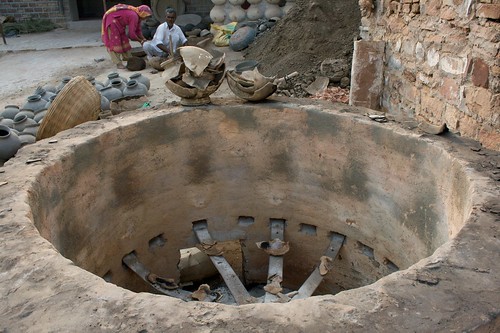 He had a very large kiln in the yard, but I didn't get to ask him how he covers it up. I'm actually curious to know. It is obviously fed by a fire which can be stoked through the hole on the bottom. It is obviously not too high temperature clay he uses as the iron doesn't melt in the kiln, which it could for a high temp firing.
He had a very large kiln in the yard, but I didn't get to ask him how he covers it up. I'm actually curious to know. It is obviously fed by a fire which can be stoked through the hole on the bottom. It is obviously not too high temperature clay he uses as the iron doesn't melt in the kiln, which it could for a high temp firing.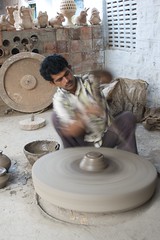 His son demonstrated the wheel they use for making most of their pots. It is basically a big flywheel mounted on something which allows it to spin. It is not held horizontal, but has to be spun up with a stick and while doing that managed to keep it from wobbling.
His son demonstrated the wheel they use for making most of their pots. It is basically a big flywheel mounted on something which allows it to spin. It is not held horizontal, but has to be spun up with a stick and while doing that managed to keep it from wobbling.  Once it is spinning well, it can be used for several minutes to make a pot. He was able to throw a pot in the space of about 2 minutes.
Once it is spinning well, it can be used for several minutes to make a pot. He was able to throw a pot in the space of about 2 minutes. After he made a couple, I was convinced to give it a try. While I had used a wheel in my parent's pottery shop when I was a teenager, it has been many years. And the one I used was motorized and high up enough to stand at. Both my attempts were flops, but it was fun to try.
After he made a couple, I was convinced to give it a try. While I had used a wheel in my parent's pottery shop when I was a teenager, it has been many years. And the one I used was motorized and high up enough to stand at. Both my attempts were flops, but it was fun to try. In the area around Jodhpur, there is a long standing tradition amongst some of the villagers of using Opium. It can be consumed in several ways, but one of the traditional ways to consume it there is by making Opium Tea.
In the area around Jodhpur, there is a long standing tradition amongst some of the villagers of using Opium. It can be consumed in several ways, but one of the traditional ways to consume it there is by making Opium Tea. 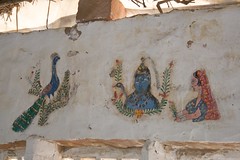 So our next stop was the house of an elderly man, his daughter and granddaughter. They demonstrated, or rather he demonstrated, how to make opium tea. He also demonstrated on me how to tie a turban, which can start at 9 meters long and go longer. They were very gentle kind people and genuinely open and friendly with their home.
So our next stop was the house of an elderly man, his daughter and granddaughter. They demonstrated, or rather he demonstrated, how to make opium tea. He also demonstrated on me how to tie a turban, which can start at 9 meters long and go longer. They were very gentle kind people and genuinely open and friendly with their home.
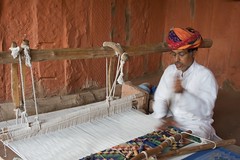 Our final stop that afternoon was at a Dhurry Weaver village. This gentleman showed us the process for weaving them, and explained the different types of wool, silks and cottons they used. He also explained how the village had been set up by the government to promote the handicrafts and create a co-op for the weavers to get better incomes. We bought a couple of lovely dhurries from him for the house.
Our final stop that afternoon was at a Dhurry Weaver village. This gentleman showed us the process for weaving them, and explained the different types of wool, silks and cottons they used. He also explained how the village had been set up by the government to promote the handicrafts and create a co-op for the weavers to get better incomes. We bought a couple of lovely dhurries from him for the house.We ended the day with going to our hotel, which was another converted palace(Rohet Garh). This one was the nicest of them all. It was very homey. The owner lives in part of it, and he met us (and I suspect most of the other guests) in the garden at tea time just after we arrived. As I said the place felt very comfortable while being a very nice hotel. It had the nicer qualites of a B&B combined with a 4 or 5 star hotel. The hotel was all lit up at night, in preparation for Dhiwali. As such it was like walking out into fairy land.
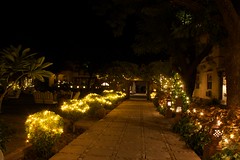
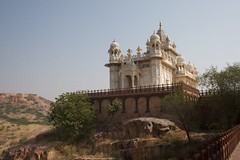 The next day we made a tour of the royal crematorium, and the fort and palace. The royal crematorium looks imposing as you come to it, until you find out the cremations didn't take place in this building. The large building is a monument built by one of the kings of Jodhpur so that his mother could look out the window and be reminded of her husband who had been cremated there. You could go inside the monumnent, where there were pictures of all of the Kings of Jodhpur, plus a space for worship.
The next day we made a tour of the royal crematorium, and the fort and palace. The royal crematorium looks imposing as you come to it, until you find out the cremations didn't take place in this building. The large building is a monument built by one of the kings of Jodhpur so that his mother could look out the window and be reminded of her husband who had been cremated there. You could go inside the monumnent, where there were pictures of all of the Kings of Jodhpur, plus a space for worship.  All kinds of people come to worship here. Many people come and tie a knot in a a handkerchief or piece of fabric or thread on the chain dividing the insides of the hall. They make a wish for something good, i.e. a child, and then once the wish is granted, they come back and remove the item. It is a nice spot with a small lake, and a nice view when it isn't hazy, like the day we were there.
All kinds of people come to worship here. Many people come and tie a knot in a a handkerchief or piece of fabric or thread on the chain dividing the insides of the hall. They make a wish for something good, i.e. a child, and then once the wish is granted, they come back and remove the item. It is a nice spot with a small lake, and a nice view when it isn't hazy, like the day we were there.From there we went to the fort proper. The fort is high up on the hill, even after you park the car. This time we rode in an elevator up to the fort. It is walkable, but the elevator saves a lot of time. The rock was hand carved to make a shaft for the elevator some years ago.
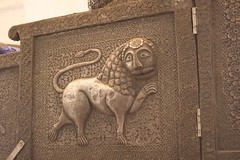 Inside there were a lot of items used by the Maharajas of the time. This silver palanquin was particularly interesting. Notice the human face on the lion.
Inside there were a lot of items used by the Maharajas of the time. This silver palanquin was particularly interesting. Notice the human face on the lion. 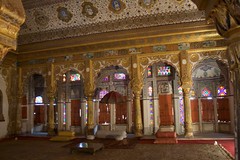 Again there were many rooms of sliver and gold. Very fancy digs for the these royals.
Again there were many rooms of sliver and gold. Very fancy digs for the these royals.The view from the fort
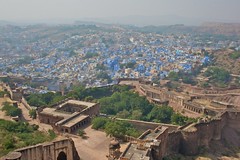 was stunning, albeit a bit hazy. You could certainly see why it is called the Blue City. And when we exited the fort, here was a camel waiting along beside all of the two wheelers parked by the entrance to the fort.
was stunning, albeit a bit hazy. You could certainly see why it is called the Blue City. And when we exited the fort, here was a camel waiting along beside all of the two wheelers parked by the entrance to the fort. After visiting the fort, we visited a textile warehouse where they had seven floors of different kinds of textiles from floor to ceiling.
After visiting the fort, we visited a textile warehouse where they had seven floors of different kinds of textiles from floor to ceiling. 
Then we went to the city market are and visited the clock tower. Since it was just before Diwali, the market was crammed with people. There were many side streets and alleys.
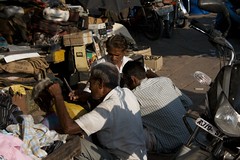 We went through a few of them, ending up at the clock tower.
We went through a few of them, ending up at the clock tower.  We saw people selling clothing, running open air barber shops and dental clinics (have your tooth removed on the street anyone?), trinkets for Diwali, and anything else you could think of. And of course children passing the time...
We saw people selling clothing, running open air barber shops and dental clinics (have your tooth removed on the street anyone?), trinkets for Diwali, and anything else you could think of. And of course children passing the time... 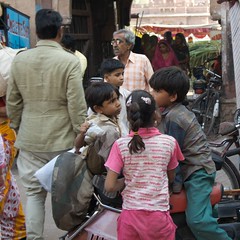
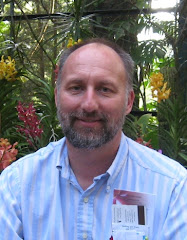
No comments:
Post a Comment